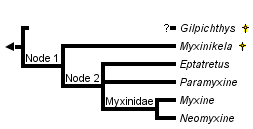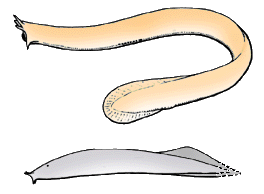Hyperotreti
Hagfishes
Philippe Janvier


This tree diagram shows the relationships between several groups of organisms.
The root of the current tree connects the organisms featured in this tree to their containing group and the rest of the Tree of Life. The basal branching point in the tree represents the ancestor of the other groups in the tree. This ancestor diversified over time into several descendent subgroups, which are represented as internal nodes and terminal taxa to the right.

You can click on the root to travel down the Tree of Life all the way to the root of all Life, and you can click on the names of descendent subgroups to travel up the Tree of Life all the way to individual species.
For more information on ToL tree formatting, please see Interpreting the Tree or Classification. To learn more about phylogenetic trees, please visit our Phylogenetic Biology pages.
close box
Node 1: tentacles
Node 2: large ventrolateral slime glands, esophago-cutaneous duct on the left side, elongate body shape.
Myxinidae: pair of common external branchial openings.
Introduction
Hagfishes are a group of marine, eel-shaped jawless fishes. There are about 20 species of hagfish, referred to four genera: Myxine, Neomyxine, Paramyxine, and Eptatretus. The former two possess a single pair of common external gill openings, a character of the Myxinidae. The latter two have minute, separate gill openings, which is regarded as the primitive condition. In Paramyxine, however, the gill openings are more closely-set than in Eptatretus, and this has been thought to represent an intermediate condition between Eptatretus and Myxinidae. The eyes, although devoid of lens and extrinsic musculature, are larger in Eptatretus and Paramyxine than in Myxine and Neomyxine, where they are partly covered by the trunk musculature.
Among craniates, hagfishes are unique in many respects, and this has long been regarded as a consequence of degeneracy due to presumed parasitic habits. However, if hagfishes may penetrate inside dead fishes to eat the liver (their favourite dish!), they are in no way endoparasites. On the contrary, they can be active predators and prey on small invertebrates at night. There is now a broad consensus over the idea that most of these unique anatomical and physiological features of hagfishes are in fact primitive and approach the condition of the common ancestor to all craniates. These features are for example their body fluid content (more than 10%, whereas it is less than 10% in all other craniates), the low oxygen affinity of their blood cells, their lack of cardiac innervation, their multiple veinous hearts, their lack of sensory-line neuromasts (although they have acoustico-lateral nerve fibres), their comparatively simple pituitary gland, or their lack of muscles in caudal fin web.
Hagfishes have an antitropical distribution, most species living in relatively cold waters of the northern and southern hemispheres. They have practically no osmoregulation and are very sensitive to drops in water salinity. Having little culinary value (except in Japan), some species of hagfishes are, however, now endangered by their exploitation for their skin, which is extremely tough and soft, and is sold worldwide as "eel skin".
Characteristics
Hagfishes are characterized by:
- Four pairs of tentacles surrounding the mouth and the opening for the nasopharyngeal duct.
- A duct leading from the esophagus to the exterior (oesophagocutaneous duct), on the left side only, and opening behind the rearmost gill opening.
- A ventrolateral series of very large glands which produce a slime made up by large thread cells.
There are several other characteristics by which hagfishes differ from all other vertebrates, but these are either absences (lack of extrinsic eye muscles, lack of eye lens, lack of cardiac innervation, lack of radial muscles, etc.) or conditions which recalls that in cephalochordates or tunicates (accessory venous hearts, disseminate pancreas, etc.). In both cases, these apparently unique hagfish features are likely to be primitive for all craniates.
The mouth of hagfishes is armed with a protractable and retractable cartilaginous plate which bears two pairs of comb-shaped horny teeth (the "rasping tongue"). These are used to grasp on the food and convey it toward the pharynx. The mouth is not involved in the intake of the respiratory water. Instead, the water is inhalated through the nasopharyngeal duct, which opens at the anterior tip of the head. It leads posteriorly to the median olfactory organ and then to the pharynx and gill pouches.
The skeleton of hagfishes is made up by a complex assemblage of cartilaginous bars (see figure on the Craniata page), which serve as antagonists to an equally complex head musculature. Cartilages also strengthen the tentacles, nasopharyngeal duct, velum, "tongue", but there are no branchial arches. Neither is there any braincase proper, the brain being surrounded by a fibrous sheath. Nevertheless, the olfactory organ and the labyrinth are enclosed in cartilaginous capsules. In the body, the only skeleton is the notochord and the cartilaginous rays of the caudal fin.
Discussion of Phylogenetic Relationships
There is no detailed phylogeny of hagfishes. However, Myxine and Neomyxine can reasonably be regarded as forming a clade, the Myxinidae, because of their unique pair of external branchial openings. Whether the Eptratretidae (Eptatretus and Paramyxine) are a clade or not is still undecided, yet tooth morphology suggests monophyly.
The only fossil hagfishes known to date are Late Carboniferous in age (about 330 million years). They are represented by Myxinikela, from the Pennsylvanian of Illinois, which shares with extant hagfishes the tentacles and long nasopharyngeal duct, but differs from them by its stout body shape and larger caudal fin. Another fossil, Gilpichthys, from the same locality and age, displays nearly the same morphology, except for the tentacles, and is questionably referred to hagfishes.
Hagfishes have long been included in the clade Cyclostomi, together with lampreys, because of their peculiar "tongue" apparatus, horny teeth and pouch-shaped gills. The cyclostomes were regarded as the sister-group of the Gnathostomata (jawed vertebrates). There is now overwhelming evidence that the cyclostomes are paraphyletic, and that hagfishes are the sister-group of lampreys and the gnathostomes; that is, the Vertebrata in the current sense. Some zoologists, however still consider the cyclostome characteristics are synapomorphies and reject cyclostome paraphyly.
References
Bardack, D. (1991). First fossil hagfish (Myxinoidea): a record from the Pennsylvanian of Illinois. Science, 254, 701-703.
Bardack, D., and Richardson, E. S. Jr. (1977). New agnathous fishes from the Pennsylvanian of Illinois. Fieldiana: Geology, 33, 489-510.
Brodal, A. and Fänge, R. (ed.) (1963). The Biology of Myxine, Universitetsforlaget, Oslo.
Fernholm, B. and Holmberg, K. (1975). The eyes in three genera of hagfish (Eptatretus, Paramyxine and Myxine) - A case of degenerative evolution. Vision Research, 15, 253-259.
Hardisty, M. W. (1982). Lampreys and hagfishes: Analysis of cyclostome relationships. In The Biology of Lampreys, (ed. M. W. Hardisty and I. C. Potter), Vol.4B, pp. 165-259. Academic Press, London.
Janvier, P. (1996). Early vertebrates. Oxford Monographs in Geology and Geophysics, 33, Oxford University Press, Oxford.
Marinelli, W. and Strenger, A. (1956). Vergleichende Anatomie und Morphologie der Wirberltiere. Myxine glutinosa. Franz Deuticke, Vienna.
Yalden, D.W. (1985). Feeding mechanisms as evidence for cyclostome monophyly. Zoological Journal of the Linnean Society. 84, 291-300.
Stock, D. W. and Whitt, G. S. (1992). Evidence from 18S ribosomal RNA that lampreys and hagfishes form a natural group. Science, 257, 787-789.
Title Illustrations

| Scientific Name | Eptatretus, Myxinikela |
|---|---|
| Comments | A modern hagfish, the Pacific hagfish Eptatretus (top), shows some of the diagnostic features of the group: the tentacles surrounding the snout, the left oesophagocutaneous opening (in the rear of the gill openings), and the series of large, ventrolateral slime glands. The earliest known fossil hagfish, Myxinikela, from the Late Carboniferous of Illinois, had a much stouter body shape but clearly shows the tentacles. |
| Reference | After Bardack, D. (1991). First fossil hagfish (Myxinoidea): a record from the Pennsylvanian of Illinois. Science 254:701-703. |
| Image Use |
 This media file is licensed under the Creative Commons Attribution License - Version 3.0. This media file is licensed under the Creative Commons Attribution License - Version 3.0.
|
| Copyright |
© 1997

|
About This Page

Muséum National d'Histoire Naturelle Paris, France
Page copyright © 1997
 Page: Tree of Life
Hyperotreti. Hagfishes.
Authored by
Philippe Janvier.
The TEXT of this page is licensed under the
Creative Commons Attribution License - Version 3.0. Note that images and other media
featured on this page are each governed by their own license, and they may or may not be available
for reuse. Click on an image or a media link to access the media data window, which provides the
relevant licensing information. For the general terms and conditions of ToL material reuse and
redistribution, please see the Tree of Life Copyright
Policies.
Page: Tree of Life
Hyperotreti. Hagfishes.
Authored by
Philippe Janvier.
The TEXT of this page is licensed under the
Creative Commons Attribution License - Version 3.0. Note that images and other media
featured on this page are each governed by their own license, and they may or may not be available
for reuse. Click on an image or a media link to access the media data window, which provides the
relevant licensing information. For the general terms and conditions of ToL material reuse and
redistribution, please see the Tree of Life Copyright
Policies.
Citing this page:
Janvier, Philippe. 1997. Hyperotreti. Hagfishes. Version 01 January 1997 (under construction). http://tolweb.org/Hyperotreti/14828/1997.01.01 in The Tree of Life Web Project, http://tolweb.org/







 Go to quick links
Go to quick search
Go to navigation for this section of the ToL site
Go to detailed links for the ToL site
Go to quick links
Go to quick search
Go to navigation for this section of the ToL site
Go to detailed links for the ToL site